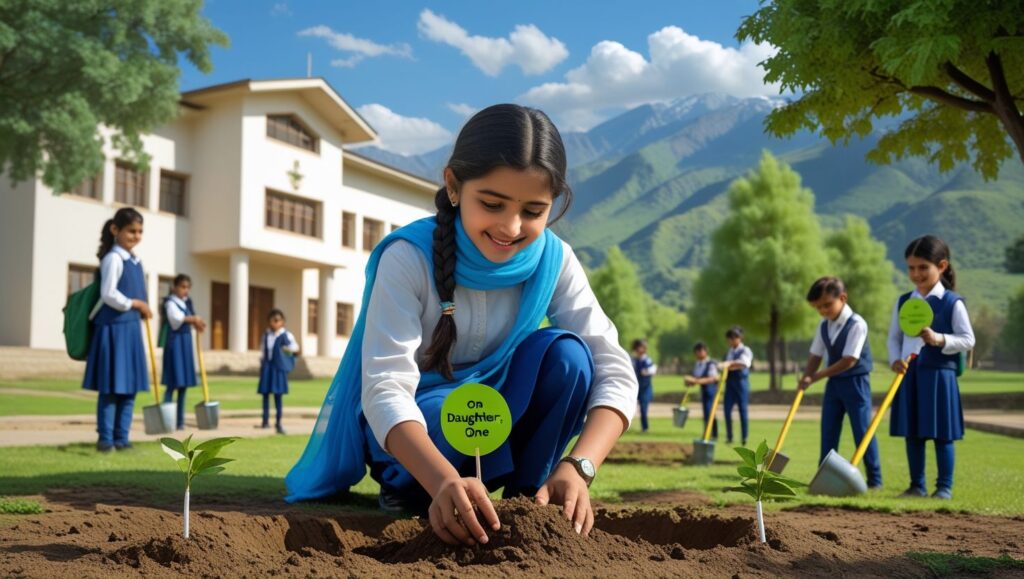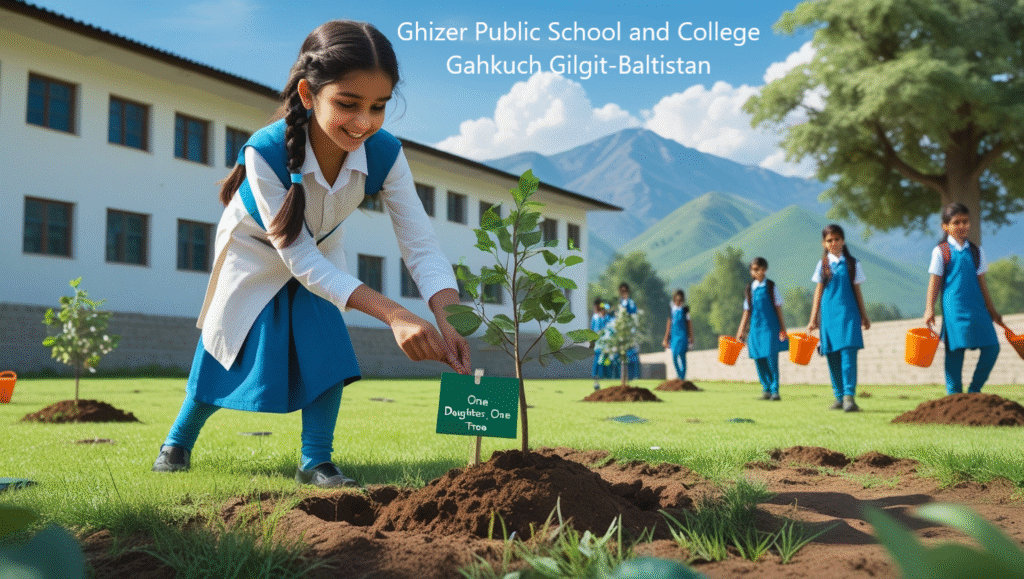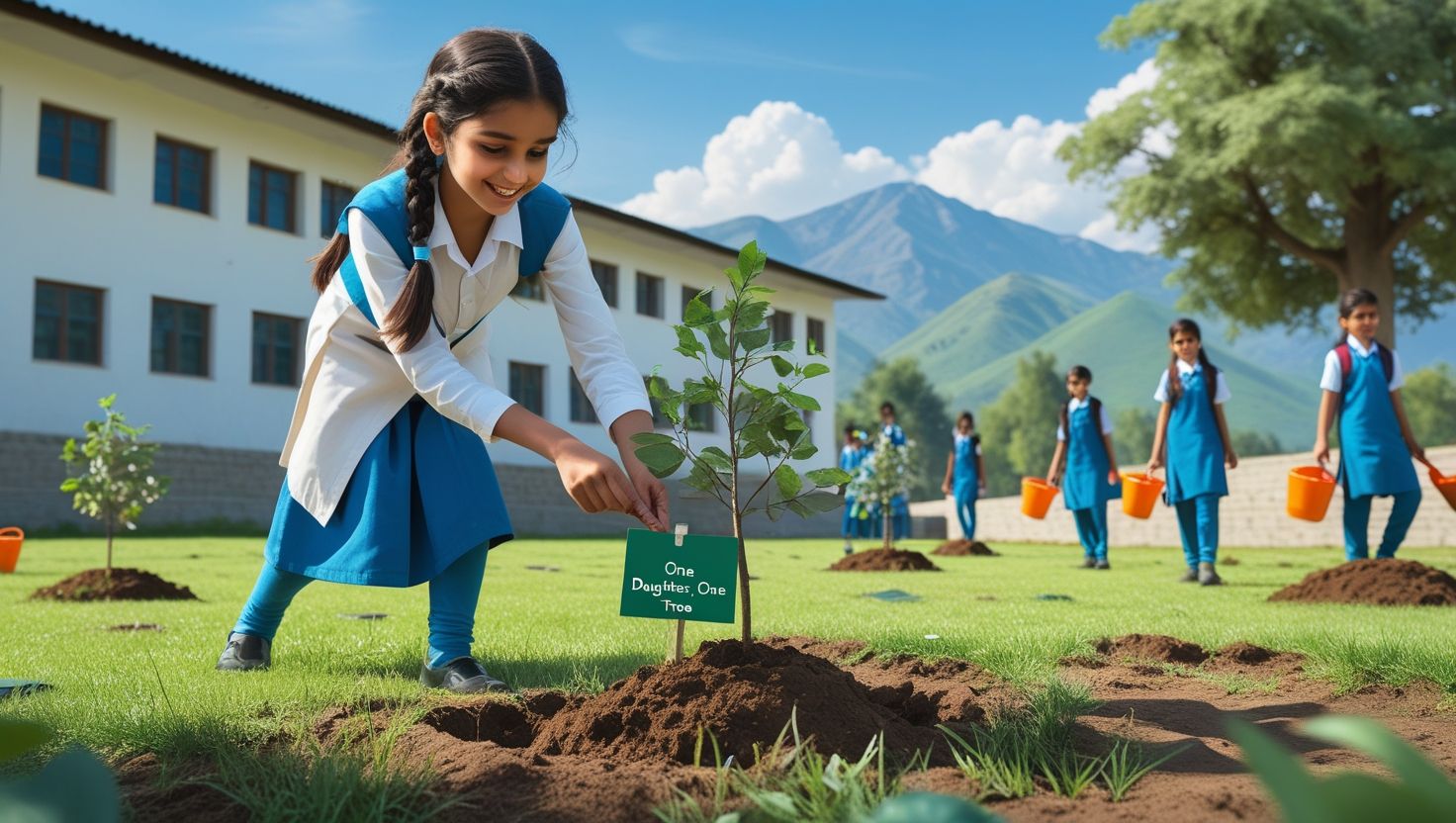Introduction
One Daughter One Tree Initiative for Climate Change, The One Daughter One Tree initiative is an innovative environmental and social movement that links the celebration of a daughter’s birth to the planting of a tree. This initiative provides a unique solution to two critical global challenges: climate change and gender equality. As the world faces rising temperatures, deforestation, and loss of biodiversity, every effort counts toward environmental restoration. Planting trees for every girl born not only strengthens the fight against global warming but also symbolizes equality, hope, and sustainability. Furthermore, this approach connects communities to nature, encouraging long-term environmental stewardship.
With this practice, families contribute to the earth while honoring their daughters. Therefore, the initiative has become a powerful tool for both climate mitigation and social awareness. In today’s world, combining ecological conservation with gender empowerment creates a profound positive impact on society and the planet.
Climate Change and the Need for Tree Planting
Climate change has emerged as one of the greatest threats to human survival. Rising greenhouse gas emissions, deforestation, and overconsumption of resources accelerate global warming. Trees are vital in absorbing carbon dioxide, releasing oxygen, and maintaining ecological balance. The One Daughter One Tree initiative directly contributes to this urgent need by increasing green cover. Planting trees reduces air pollution, prevents soil erosion, and restores groundwater levels. Consequently, it improves biodiversity and supports climate resilience.
Moreover, trees act as natural carbon sinks, helping mitigate the impacts of industrialization and urbanization. Therefore, planting a tree for every daughter born is not just symbolic; it is an essential climate action strategy. By promoting large-scale tree plantations, the initiative helps reduce climate risks while creating healthier communities. It bridges the gap between environmental action and social commitment, ensuring sustainability for future generations.
The Social Significance of the Initiative
Beyond the environmental benefits, the One Daughter One Tree campaign also carries strong social significance. In many societies, daughters often face discrimination, and their births are sometimes undervalued compared to sons. By linking a daughter’s birth with the planting of a tree, communities send a message of equality and respect. This practice empowers families to take pride in their daughters while also contributing to climate change solutions. Moreover, it fosters a sense of responsibility among parents, encouraging them to care for both the child and the planted tree as they grow together.
The symbolic connection between nurturing a daughter and nurturing a tree emphasizes harmony, sustainability, and inclusivity. In rural and urban settings alike, the initiative helps challenge stereotypes and encourages gender balance. Therefore, this movement demonstrates how social transformation and environmental conservation can complement each other effectively.
How the Initiative Supports Gender Equality
The One Daughter One Tree initiative is more than a tree plantation drive; it is a movement toward gender equality. In societies where daughters are often undervalued, planting trees in their honor shifts perspectives. Families take pride in linking their daughters’ futures with nature’s growth. This symbolic gesture challenges long-standing biases against girls. Furthermore, it highlights the role of women as contributors to sustainable development. As daughters grow, they witness their symbolic tree’s growth, reinforcing their identity and self-worth.
The campaign also creates awareness about women’s contributions to society and the environment. Therefore, the initiative addresses deep-rooted cultural issues while promoting climate action. By elevating the status of daughters, it encourages communities to adopt inclusive practices. In this way, environmental conservation and gender empowerment move forward hand in hand, building a more sustainable and fair future for all.

Environmental Benefits of Planting Trees
Planting trees is one of the most effective strategies to combat climate change. Trees absorb harmful greenhouse gases and improve air quality. They also regulate temperature, provide shade, and protect biodiversity. By implementing the One Daughter One Tree initiative, millions of trees can be planted worldwide, creating a significant environmental impact. Each tree provides habitat for birds, insects, and small animals, restoring ecosystems that have been damaged by urbanization. Additionally, trees improve soil fertility and prevent land degradation.
Water cycles are also supported, as roots help in groundwater recharge. Beyond local benefits, large-scale tree planting directly contributes to reducing global warming. The initiative demonstrates how simple actions can have long-term ecological benefits. By associating tree planting with the birth of daughters, the campaign strengthens both family pride and environmental responsibility, ensuring that every new generation inherits a greener planet.
Combating Deforestation through the Initiative
Deforestation is one of the leading causes of global warming, biodiversity loss, and land degradation. The One Daughter One Tree initiative helps to directly counteract these effects by encouraging families to plant trees consistently. Since deforestation is often driven by urban expansion, agriculture, and logging, this campaign provides a balance by replenishing green cover. Each tree planted becomes a step toward reversing the damage caused by forest destruction. Moreover, community-driven plantation programs strengthen public awareness about the importance of forests.
With continuous participation, the initiative can create micro-forests in both rural and urban areas. Furthermore, trees planted for each daughter symbolize resilience against exploitation of nature. This approach not only reduces carbon footprints but also builds collective responsibility. Therefore, the initiative plays a vital role in restoring ecological balance and combating the harmful effects of deforestation worldwide.
Linking the Initiative with Sustainable Development Goals
The One Daughter One Tree initiative aligns strongly with the United Nations Sustainable Development Goals (SDGs). Firstly, it supports Goal 13: Climate Action by reducing carbon emissions and promoting tree plantation. Secondly, it fosters Goal 5: Gender Equality by valuing daughters and empowering families to celebrate their birth. Furthermore, the campaign also contributes to Goal 15: Life on Land, as it enhances biodiversity and restores ecosystems. Communities benefit from improved water resources, healthier environments, and sustainable practices. Beyond environmental impact, the initiative strengthens social unity and inclusiveness.
Governments and NGOs can integrate this program into development strategies, ensuring long-term results. Therefore, the movement demonstrates how environmental and social goals can be combined to create lasting positive change. Linking daughters with trees becomes a practical way of achieving multiple SDGs simultaneously, making it a model for global adoption.
Economic Impacts of the Initiative
The One Daughter One Tree program also brings measurable economic benefits. Tree planting contributes to long-term savings in healthcare by reducing pollution-related diseases. Moreover, trees provide fruits, timber, and shade, contributing to community livelihoods. Families who plant trees can benefit economically from their growth over time. Furthermore, green spaces improve real estate value and attract eco-tourism. In rural areas, planted trees can support agriculture by preventing soil erosion and increasing fertility.
Additionally, governments save costs in climate mitigation efforts when communities actively participate in such campaigns. As a result, the initiative has both direct and indirect economic advantages. By connecting tree planting to the birth of daughters, the campaign adds emotional and cultural value, encouraging families to protect trees. Therefore, it creates a sustainable cycle where environmental responsibility and economic benefits grow together, building stronger and healthier societies.

Community Participation and Awareness
The success of the One Daughter One Tree initiative depends largely on community participation. When families and local groups join together, they create a collective sense of responsibility toward nature. Community-driven plantations strengthen social bonds, inspire cooperation, and raise environmental awareness. Moreover, schools and colleges can integrate the campaign into educational activities, teaching children about climate change and sustainability. NGOs and local governments can provide seedlings, training, and resources to ensure long-term tree survival. Furthermore, the initiative spreads awareness about the importance of valuing daughters, helping shift cultural attitudes.
Celebrating a girl’s birth with a tree strengthens community pride while also addressing climate issues. When people work together, the impact multiplies, and the message reaches wider audiences. Therefore, community participation ensures that the initiative is not just symbolic but becomes a practical solution for climate change and gender equity.
Role of Governments and NGOs
The One Daughter One Tree program requires strong support from governments and NGOs to reach its full potential. Governments can create policies that encourage families to adopt tree-planting traditions. Financial incentives, free saplings, and awareness campaigns can strengthen participation. NGOs, on the other hand, can mobilize communities, provide training, and ensure that planted trees survive and thrive.
Moreover, partnerships between public and private sectors can help scale up the initiative at national and global levels. Schools, universities, and media platforms can also play an important role in spreading the campaign. Furthermore, linking this initiative with existing climate and gender programs maximizes its impact. With consistent efforts, millions of trees can be planted annually. Therefore, collaboration between governments, NGOs, and citizens ensures that the initiative contributes significantly to fighting climate change and promoting gender equality worldwide.
Challenges Faced by the Initiative
Although the One Daughter One Tree initiative is highly impactful, it also faces challenges. Firstly, ensuring the survival of planted trees requires consistent care, which families may neglect over time. Secondly, in regions with water scarcity, maintaining trees becomes difficult. Furthermore, limited awareness and cultural resistance may slow down adoption. Some communities may still undervalue daughters, which weakens the program’s effectiveness. Additionally, lack of government support and insufficient resources for large-scale tree planting present obstacles.
Climate conditions, such as droughts and floods, can also affect tree survival. However, these challenges can be addressed through training, awareness campaigns, and policy support. By involving schools, NGOs, and local leaders, communities can overcome these hurdles. Therefore, while difficulties exist, they should not discourage progress. With consistent effort, the initiative can overcome barriers and grow into a global movement for climate and gender justice.
Global Potential of the Initiative
The One Daughter One Tree program holds significant potential for global adoption. Although it originated in certain communities, the idea can easily be implemented worldwide. Every country faces challenges related to climate change and gender equality. By linking these two issues, the initiative creates a powerful, adaptable solution. Governments, NGOs, and individuals can all participate in promoting this campaign. Moreover, international organizations can provide funding, resources, and awareness platforms to scale it globally.
When adopted worldwide, the movement could result in billions of new trees, directly helping to reduce carbon emissions. At the same time, it fosters equality and inclusiveness in diverse cultures. Furthermore, global cooperation ensures knowledge sharing and long-term sustainability. Therefore, the initiative has the potential to become a universal symbol of environmental protection and gender respect, creating lasting impacts for humanity and the planet.

Success Stories and Real-World Examples
Many communities have already embraced the One Daughter One Tree concept with success. For example, in parts of India, families celebrate their daughters’ births by planting trees, creating green villages. These efforts not only improve the environment but also transform social attitudes toward girls. Similarly, NGOs across Asia and Africa have initiated plantation programs that connect gender empowerment with environmental sustainability. Local schools have organized tree planting events to spread awareness among students. In several regions, governments provide incentives for families who participate, ensuring large-scale adoption. The visible growth of trees over years inspires pride and responsibility in families.
Moreover, these stories demonstrate that the initiative is practical, impactful, and replicable. Therefore, real-world examples highlight how communities can create lasting change by combining cultural practices with environmental conservation. They serve as models for global replication and expansion of the movement.
Role of Education in Promoting the Initiative
Education plays a central role in strengthening the One Daughter One Tree movement. Schools and colleges can integrate tree planting with lessons on climate change, biodiversity, and gender equality. Teachers can guide students in understanding how planting trees helps fight global warming while also respecting daughters. Moreover, awareness campaigns in educational institutions create ripple effects, as students carry messages to their families and communities. Environmental clubs can organize plantation drives, linking the initiative with sustainable practices.
Furthermore, educating children about the importance of equality builds long-term cultural change. With proper guidance, students can become ambassadors for the initiative, ensuring it grows stronger across generations. Therefore, education not only enhances awareness but also ensures continuity of the program. By fostering young leaders, schools and universities make the campaign a lasting contribution to environmental and social development.
Long-Term Vision of the Initiative
The One Daughter One Tree initiative is not just about planting trees but about creating a long-term vision for sustainability and equality. Over decades, the campaign can transform landscapes, increase forest cover, and reduce carbon footprints. At the same time, it can change cultural attitudes, ensuring daughters are celebrated equally. The long-term vision includes building eco-friendly societies where human progress does not harm nature. Families will not only take pride in their daughters but also in the environmental legacy they leave behind.
Governments can integrate the initiative into climate action policies, making it a core part of development. Furthermore, by linking personal milestones with environmental responsibility, the movement fosters a culture of stewardship. Therefore, the long-term vision is to create a greener, healthier, and more equal world for future generations. This dual impact makes the initiative truly transformative.
Conclusion: A Symbol of Hope and Change
The One Daughter One Tree initiative represents a powerful blend of environmental action and social transformation. By celebrating daughters with tree planting, communities fight climate change and promote gender equality simultaneously. Each tree planted symbolizes life, growth, and sustainability, while each daughter celebrated reflects progress toward inclusivity.
The initiative aligns with global sustainable development goals and creates economic, ecological, and cultural benefits. Although challenges exist, awareness, education, and policy support can ensure its success. Furthermore, the program has the potential to spread globally, creating billions of trees and changing attitudes worldwide. Ultimately, it is more than a campaign—it is a vision of hope for the planet and society. Therefore, the initiative should be embraced, supported, and expanded, making every daughter’s birth a celebration of both humanity and nature.
References
- United Nations. (2015). Sustainable Development Goals. Retrieved from https://sdgs.un.org/goals
- FAO. (2020). The State of the World’s Forests 2020. Rome: Food and Agriculture Organization.
- IPCC. (2021). Climate Change 2021: The Physical Science Basis. Intergovernmental Panel on Climate Change.
- UN Women. (2022). Gender Equality and Climate Action. Retrieved from https://www.unwomen.org

Very useful tips! I’m excited to implement them soon.
Your breakdown of the topic is so well thought out.
This content is gold. Thank you so much!
You’re doing a fantastic job with this blog.
Thank you for covering this so thoroughly. It helped me a lot.
I always look forward to your posts. Keep it coming!
This was easy to follow, even for someone new like me.
Such a simple yet powerful message. Thanks for this.
You’ve sparked my interest in this topic.
Very useful tips! I’m excited to implement them soon.
I appreciate the depth and clarity of this post.
Thanks for addressing this topic—it’s so important.
I am not sure where youre getting your info but good topic I needs to spend some time learning much more or understanding more Thanks for magnificent info I was looking for this information for my mission
qwz8u5